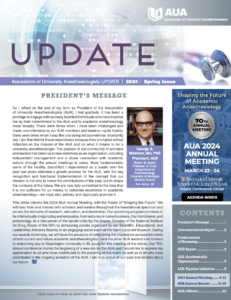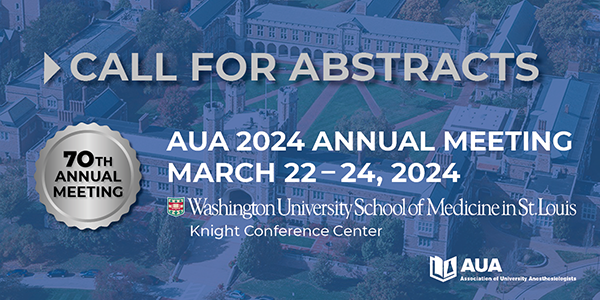Galvanizing Neuroimmunity: Implication for Perioperative Neurocognitive Disorders
The nervous system connects to virtually every cell in the body, and regulates remote organ function via rapid and fine-tuned circuits. The vagus nerve, a major component of the bidirectional communication between the brain and peripheral organs, is one of the best-studied circuits for central/peripheral neuro/immune interactions1. Tracey and colleagues were the first to describe the so-called “inflammatory reflex”, a vagally-mediated neuronal circuit that can provide information about the body’s inflammatory status to the brain in real time2. The cellular machinery underlying this inflammatory reflex is complex, with several intermediate players including the celiac ganglion, splenic nerve axons, acetylcholine-releasing subset of T cells, and monocyte-derived macrophages3. More specifically, acetylcholine released after vagus nerve stimulation (VNS) significantly inhibits pro-inflammatory cytokine release via mechanism(s) that require expression of the α7 subtype of nicotinic acetylcholine receptor (α7 nAChR)4, and cytoprotective effects of VNS or cholinergic agonists have been demonstrated in a variety of acute and chronic inflammatory conditions including rheumatoid arthritis5.
VNS is providing a selective and targeted approach to modulating inflammation including central nervous system (CNS) inflammation, or neuroinflammation, which contributes to many neurologic conditions6. Mounting evidence implicates neuroinflammation in the pathophysiology of perioperative neurocognitive disorders (PND), which now encompass postoperative delirium and long-term postoperative cognitive dysfunction, especially as they relate to the acute-phase response to surgical trauma7. PND has become a quintessential geriatric complication that affects up to 40% of older adults, and is associated with significant mortality and morbidity, reduced quality of life, and substantial healthcare costs8. Patients with delirium and cognitive decline following anesthesia and surgery have high levels of inflammatory and neuronal damage biomarkers in different bodily fluids as well as increased neuroinflammation based on imaging of microglial reactivity (recently reviewed in9). Mouse models of PND have recapitulated similar changes in the (neuro)inflammatory response to peripheral surgery. Notably, using prophylactic agonists of α7 nAChR to harness cholinergic signaling prior to orthopedic surgery prevents trauma-induced neuroinflammation, endothelial dysfunction, and subsequent cognitive decline by inhibiting pro-inflammatory cytokine release and nuclear factor (NF)-kB activation in monocyte-derived peripheral macrophages10-13. Currently, minimally invasive approaches to VNS, such as ultrasound-guided needle electrode placement on the vagus nerve, are also providing significant anti-inflammatory effects by modulating microglial morphology and delirium-like behavior in mice14.
This is an exciting time for biomedical research when molecular medicine, bioengineering, neuroscience, immunology, and physiology are connecting to develop and implement technologies that can monitor and treat neuroinflammatory disorders. Bioelectronic medicine is rapidly establishing its footprint across different fields including anesthesiology and perioperative medicine15. Mechanistically-driven studies to fully elucidate the translational potential for this growing discipline are needed, especially to better characterize neuro-immune interactions. For example, in addition to the well-defined actions of cholinergic signaling in regulating inflammation as part of the splenic anti-inflammatory reflex, acetylcholine is an important neurotransmitter that modulates synaptic plasticity processes involved in both hippocampal plasticity and memory. Neurons expressing choline acetyltransferase, an important enzyme in acetylcholine biosynthesis, play a role in controlling adult neurogenesis16. Indeed, surgery can impair neurogenesis in different PND preclinical models. After orthopedic surgery in rodents, we found changes in synaptic plasticity and hippocampal long-term potentiation, with pain signaling being critically implicated in this response17,18. Recent evidence suggests that neurogenesis is also impaired in humans with Alzheimer’s disease; thus, its modulation in disease states may offer solutions to neurodegenerative conditions that do not yet have effective therapy19. Since there are parallels between the pathologic features of neurodegeneration and delayed neurocognitive recovery, it is plausible for acute synaptic dysfunction, and perhaps loss of neurogenesis soon after surgery-induced neuroinflammation, to contribute to prolonged memory decline. Further studies are warranted to address these questions, and to determine whether bioelectronic approaches may be used to modulate these endpoints in PND. Recent data from elective surgical patients suggest that acetylcholinesterase activity is higher in patients with delirium, supporting the potential of altered cholinergic regulation in treating or preventing postoperative delirium22. Further, patients in perioperative or critical care are, to varying degrees, unable to maintain homeostasis including body temperature, heart rate, blood pressure, and a wide range of other organ functions that regulate their internal physiology, due to combinations of therapeutic interventions (eg, surgery and anesthesia) and disease. Decreased vagus nerve activity is also evident in patients with acute inflammatory conditions24,25 as well as in older patients26,27. Thus, boosting cholinergic signaling within the vagal reflex pathway has the potential to provide a novel strategy for reducing inflammatory conditions, including PND.
The possibility of regulating a predictable injury, such as aseptic trauma, is providing new frontiers for applying bioelectronic strategies to curtail excessive inflammation. The ability to tightly control the dose, intensity, and duration of electrical impulses via VNS holds promise for delivering better therapeutic anti-inflammatory outcomes that may be personalized to individual patient needs. The atmosphere is electric, and neuromodulation may soon provide more targeted treatments that are urgently needed for common perioperative complications.
Disclosures
Part of this work in the Terrando laboratory is funded by the National Institute of Aging. NT is Associate Editor for Bioelectronic Medicine, Springer-Nature publishing.
References
- Terrando N, Pavlov VA. Editorial: Neuro-Immune Interactions in Inflammation and Autoimmunity. Front Immunol 2018;9:772.
- Pavlov VA, Chavan SS, Tracey KJ. Molecular and Functional Neuroscience in Immunity. Annu Rev Immunol 2018;36:783-812.
- Rosas-Ballina M, Olofsson PS, Ochani M, et al. Acetylcholine-synthesizing T cells relay neural signals in a vagus nerve circuit. Science 2011;334(6052):98-101.
- Wang H, Liao H, Ochani M, et al. Cholinergic agonists inhibit HMGB1 release and improve survival in experimental sepsis. Nat Med 2004;10(11):1216-1221.
- Koopman FA, Chavan SS, Miljko S, et al. Vagus nerve stimulation inhibits cytokine production and attenuates disease severity in rheumatoid arthritis. Proc Natl Acad Sci U S A 2016;113(29):8284-8289.
- Heneka MT, Carson MJ, El Khoury J, et al. Neuroinflammation in Alzheimer's disease. Lancet Neurol 2015;14(4):388-405.
- The Perioperative Neurocognitive Disorders. Cambridge: Cambridge University Press; 2019.
- Inouye SK, Westendorp RG, Saczynski JS. Delirium in elderly people. Lancet 2014;383(9920):911-922.
- Subramaniyan S, Terrando N. Neuroinflammation and Perioperative Neurocognitive Disorders. Anesth Analg 2019;128(4):781-788.
- Terrando N, Eriksson LI, Ryu JK, et al. Resolving postoperative neuroinflammation and cognitive decline. Ann Neurol 2011;70(6):986-995.
- Terrando N, Yang T, Ryu JK, et al. Stimulation of the alpha7 Nicotinic Acetylcholine Receptor Protects against Neuroinflammation after Tibia Fracture and Endotoxemia in Mice. Mol Med 2015;20(1):667-675.
- Han Z, Li L, Wang L, et al. Alpha-7 nicotinic acetylcholine receptor agonist treatment reduces neuroinflammation, oxidative stress, and brain injury in mice with ischemic stroke and bone fracture. J Neurochem 2014;131(4):498-508.
- Su X, Feng X, Terrando N, et al. Dysfunction of inflammation-resolving pathways is associated with exaggerated postoperative cognitive decline in a rat model of the metabolic syndrome. Mol Med 2012;18:1481-1490.
- Huffman WJ, Subramaniyan S, Rodriguiz RM, et al. Modulation of neuroinflammation and memory dysfunction using percutaneous vagus nerve stimulation in mice. Brain Stimul 2019;12(1):19-29.
- Steinberg BE, Sundman E, Terrando N, et al. Neural Control of Inflammation: Implications for Perioperative and Critical Care. Anesthesiology 2016;124(5):1174-1189.
- Paez-Gonzalez P, Asrican B, Rodriguez E, et al. Identification of distinct ChAT(+) neurons and activity-dependent control of postnatal SVZ neurogenesis. Nat Neurosci 2014;17(7):934-942.
- Terrando N, Gomez-Galan M, Yang T, et al. Aspirin-triggered resolvin D1 prevents surgery-induced cognitive decline. FASEB J 2013;27(9):3564-3571.
- Zhang MD, Barde S, Yang T, et al. Orthopedic surgery modulates neuropeptides and BDNF expression at the spinal and hippocampal levels. Proc Natl Acad Sci U S A 2016;113(43):E6686-E6695.
- Moreno-Jiménez EP, Flor-García M, Terreros-Roncal J, et al. Adult hippocampal neurogenesis is abundant in neurologically healthy subjects and drops sharply in patients with Alzheimer’s disease. Nature Medicine 2019.
- Monje ML, Toda H, Palmer TD. Inflammatory blockade restores adult hippocampal neurogenesis. Science 2003;302(5651):1760-1765.
- Villeda SA, Luo J, Mosher KI, et al. The ageing systemic milieu negatively regulates neurogenesis and cognitive function. Nature 2011;477(7362):90-94.
- Muller A, Olbert M, Heymann A, et al. Relevance of peripheral cholinesterase activity on postoperative delirium in adult surgical patients (CESARO): A prospective observational cohort study. Eur J Anaesthesiol 2019;36(2):114-122.
- Sloan RP, McCreath H, Tracey KJ, et al. RR interval variability is inversely related to inflammatory markers: the CARDIA study. Mol Med 2007;13(3-4):178-184.
- Pontet J, Contreras P, Curbelo A, et al. Heart rate variability as early marker of multiple organ dysfunction syndrome in septic patients. J Crit Care 2003;18(3):156-163.
- Schmidt H, Hoyer D, Hennen R, et al. Autonomic dysfunction predicts both 1- and 2-month mortality in middle-aged patients with multiple organ dysfunction syndrome. Crit Care Med 2008;36(3):967-970.
- Huikuri HV, Makikallio TH, Airaksinen KE, et al. Power-law relationship of heart rate variability as a predictor of mortality in the elderly. Circulation 1998;97(20):2031-2036.
- Sajadieh A, Nielsen OW, Rasmussen V, et al. Increased heart rate and reduced heart-rate variability are associated with subclinical inflammation in middle-aged and elderly subjects with no apparent heart disease. Eur Heart J 2004;25(5):363-370.











